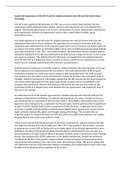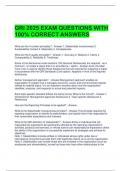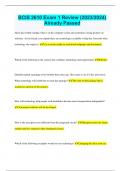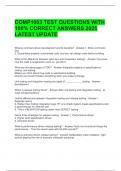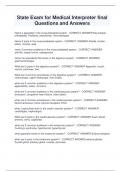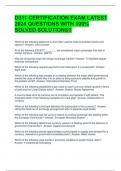INTERNATIONAL MANAGEMENT
Week 1: International Business Functions
Exporting nearly always increases revenue and economies of scale as the foreign markets are
way bigger than the home markets.
Pitfalls of exporting: unfamiliar with foreign market; small firms are easily intimidated by the
size of the market but also to the different language/legal system etc; new exporters often
underestimate the needed amount of resources.
Sogo shosha: Japanese trading houses, where people can gain knowledge about exporting.
In the USA this can be found in the U.S. Department of Commerce.
Export-import service providers:
1. Freight forwarders: regulate transportation for companies which ship
international and combine smaller shipments into one larger to save costs.
2. Export management companies (EMC): deal with export documentation for
firms.
3. Export trading companies: provide documentation/logistics/transportation
service.
4. Export packaging companies: advise on design and materials for the
packaging of their items per country.
5. Custom brokers: service to avoid pitfalls in customs regulations.
6. Confirming houses/buying agents: represents companies that want to buy
your product and bargain the lowest price for them.
7. Export agents and merchants: buy products directly from manufacturer and
package and label it to own satisfaction.
8. Piggyback marketing: arrangement whereby one firm distributes another
firm’s products (usually complementary products).
9. Economic processing zones (EPZ): foreign trade zones/special economic
zones/bonded warehouses etc. Used to receive shipments of products that
are then reshipped in smaller lots to customers throughout surrounding
areas.
Export strategies:
Hire an EMC to identify opportunities and navigate paperwork/regulations.
Initially focus on one or a few exporting markets.
Enter foreign market on small scale to reduce costs of any subsequent failure.
Hire additional personnel.
Invest time to build relationships with local distributors/customers.
Hire local personnel.
Be proactive.
Retain local production as well.
CORE-tool is a company readiness to export tool to assess a company’s readiness to export
and the product’s readiness to export.
Main problem in exporting is the lack of trust in a stranger solved by interference of bank.
1. Letter of credit: issued by the bank, bank trusts local importer so agrees to pay on his
behalf, specified in this document. States bank pays in name of importer, financial contract
with a certain paying fee for the importer (0.5%-2%).
, 2. The bill of lading: receipt issued to the exporter by the common carrier transporting the
merch. Consists of receipt, contract, document of title (can be used to obtain payment
before merch is released to the importer) and collateral (onderpand).
3. The draft (bill of exchange): payment request of the exporter (maker) to the bank
(drawee).
- Sight draft: pay when the exchange happens.
- Time draft: allows for a certain time to pay after receiving the product.
There are two assistance programs in US to support exporters:
- Export-Import bank, assists through loans to support employment and
competitiveness. Also lend foreigners US dollars so they can buy US exporting products.
- Foreign credit insurance association, when exporter has no letter of credit, they can
insure against importer defaults by buying export credit insurance.
Countertrade: trading goods for goods. E.g. when Saudi-Arabia received a Boeing in trade for
Oil. Types of countertrade:
- Barter: direct exchange of goods between two parties without a cash transaction.
- Counter purchase: reciprocal buying agreement; when a firm agrees to purchase a certain
amount of material back from the company of a country in which sale is made.
- Offset: one party agrees to buy back a certain percentage of sale price in materials, but not
necessarily from the same company.
- Switch trading: when a third-party trading house buys the firm counter-purchase credits
and sells them to another firm.
- Compensation and buybacks: firm build plant/technology/supply etc. and the country
agrees to take a percentage out of its output as payment for the contract.
Pros of countertrade: useful to companies which might not have hard resources available;
sometimes necessary by the country (US/Egypt)
Cons: might receive poor/unusable products; firms prefer hard currency; requires in-house
trading departments; can be expensive and time consuming.
most attractive to large multinationals which have a big network and thus can best make
use of different product trades.
Lately some barriers to export have been decreased through: decline in trade barriers;
increase in (regional) economic agreements; advances in technology and communication.
Case: tata motors and exporting
Indian automotive company who globally export products (Africa, Asia and Latin-America).
Debate: should tata motors further export?
Pros:
- Broad and diversified portfolio of products.
- Long and successful history in India, large market share.
- Already exporting.
- Big brands in its portfolio.
- Knows local needs.
- Existing networks and channels.
Cons:
- Possible reputation damage?
Week 1: International Business Functions
Exporting nearly always increases revenue and economies of scale as the foreign markets are
way bigger than the home markets.
Pitfalls of exporting: unfamiliar with foreign market; small firms are easily intimidated by the
size of the market but also to the different language/legal system etc; new exporters often
underestimate the needed amount of resources.
Sogo shosha: Japanese trading houses, where people can gain knowledge about exporting.
In the USA this can be found in the U.S. Department of Commerce.
Export-import service providers:
1. Freight forwarders: regulate transportation for companies which ship
international and combine smaller shipments into one larger to save costs.
2. Export management companies (EMC): deal with export documentation for
firms.
3. Export trading companies: provide documentation/logistics/transportation
service.
4. Export packaging companies: advise on design and materials for the
packaging of their items per country.
5. Custom brokers: service to avoid pitfalls in customs regulations.
6. Confirming houses/buying agents: represents companies that want to buy
your product and bargain the lowest price for them.
7. Export agents and merchants: buy products directly from manufacturer and
package and label it to own satisfaction.
8. Piggyback marketing: arrangement whereby one firm distributes another
firm’s products (usually complementary products).
9. Economic processing zones (EPZ): foreign trade zones/special economic
zones/bonded warehouses etc. Used to receive shipments of products that
are then reshipped in smaller lots to customers throughout surrounding
areas.
Export strategies:
Hire an EMC to identify opportunities and navigate paperwork/regulations.
Initially focus on one or a few exporting markets.
Enter foreign market on small scale to reduce costs of any subsequent failure.
Hire additional personnel.
Invest time to build relationships with local distributors/customers.
Hire local personnel.
Be proactive.
Retain local production as well.
CORE-tool is a company readiness to export tool to assess a company’s readiness to export
and the product’s readiness to export.
Main problem in exporting is the lack of trust in a stranger solved by interference of bank.
1. Letter of credit: issued by the bank, bank trusts local importer so agrees to pay on his
behalf, specified in this document. States bank pays in name of importer, financial contract
with a certain paying fee for the importer (0.5%-2%).
, 2. The bill of lading: receipt issued to the exporter by the common carrier transporting the
merch. Consists of receipt, contract, document of title (can be used to obtain payment
before merch is released to the importer) and collateral (onderpand).
3. The draft (bill of exchange): payment request of the exporter (maker) to the bank
(drawee).
- Sight draft: pay when the exchange happens.
- Time draft: allows for a certain time to pay after receiving the product.
There are two assistance programs in US to support exporters:
- Export-Import bank, assists through loans to support employment and
competitiveness. Also lend foreigners US dollars so they can buy US exporting products.
- Foreign credit insurance association, when exporter has no letter of credit, they can
insure against importer defaults by buying export credit insurance.
Countertrade: trading goods for goods. E.g. when Saudi-Arabia received a Boeing in trade for
Oil. Types of countertrade:
- Barter: direct exchange of goods between two parties without a cash transaction.
- Counter purchase: reciprocal buying agreement; when a firm agrees to purchase a certain
amount of material back from the company of a country in which sale is made.
- Offset: one party agrees to buy back a certain percentage of sale price in materials, but not
necessarily from the same company.
- Switch trading: when a third-party trading house buys the firm counter-purchase credits
and sells them to another firm.
- Compensation and buybacks: firm build plant/technology/supply etc. and the country
agrees to take a percentage out of its output as payment for the contract.
Pros of countertrade: useful to companies which might not have hard resources available;
sometimes necessary by the country (US/Egypt)
Cons: might receive poor/unusable products; firms prefer hard currency; requires in-house
trading departments; can be expensive and time consuming.
most attractive to large multinationals which have a big network and thus can best make
use of different product trades.
Lately some barriers to export have been decreased through: decline in trade barriers;
increase in (regional) economic agreements; advances in technology and communication.
Case: tata motors and exporting
Indian automotive company who globally export products (Africa, Asia and Latin-America).
Debate: should tata motors further export?
Pros:
- Broad and diversified portfolio of products.
- Long and successful history in India, large market share.
- Already exporting.
- Big brands in its portfolio.
- Knows local needs.
- Existing networks and channels.
Cons:
- Possible reputation damage?

